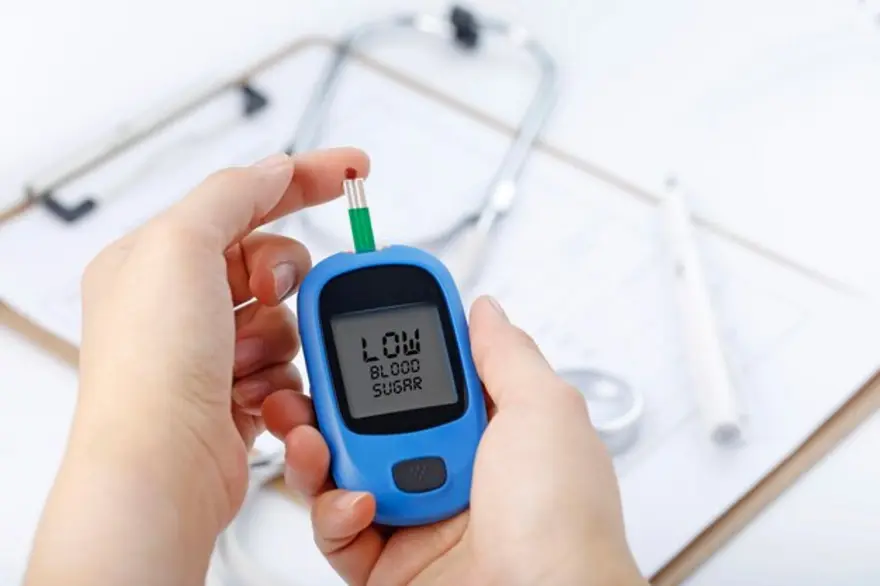Reactive hypoglycemia, a condition characterized by low blood sugar following a meal, can be both perplexing and disruptive to daily life. While it’s not as widely discussed as diabetes, it’s equally important to understand and manage. This blog aims to shed light on this condition, offering practical reactive hypoglycemia treatment options. From understanding the underlying causes to implementing dietary and lifestyle changes, we’ll explore a holistic approach to maintaining stable blood sugar levels and enhancing overall well-being.
Contents
How Can I Test For Reactive Hypoglycemia At Home?
 Testing for reactive hypoglycemia at home primarily involves monitoring your blood sugar levels, especially about meals. Here are steps you can follow to test for reactive hypoglycemia at home:
Testing for reactive hypoglycemia at home primarily involves monitoring your blood sugar levels, especially about meals. Here are steps you can follow to test for reactive hypoglycemia at home:
- Purchase a Reliable Blood Glucose Monitor: To begin testing, you’ll need a good quality blood glucose meter. These are available at most pharmacies and online. Make sure to also have enough test strips and lancets.
- Record Your Baseline Blood Sugar: Before starting the test, it’s important to know your normal blood sugar levels. For a few days, check your blood sugar when you wake up (fasting blood sugar) and note these readings.
- Monitor Blood Sugar After Meals: The key to testing for reactive hypoglycemia is to check your blood sugar levels at regular intervals after eating. Typically, you should check your blood sugar 1, 2, and 3 hours after a meal.
- Keep a Food Diary: Alongside your blood sugar readings, maintain a detailed record of what you eat and drink. Note the time, types of food, portion sizes, and how you feel after eating. This information can help identify specific foods or patterns that might be triggering hypoglycemic episodes.
- Look for Symptoms: Be aware of any symptoms of hypoglycemia you might experience, such as dizziness, sweating, confusion, shakiness, or hunger, and record these in your diary with the time they occur.
- Interpreting Results: Generally, a blood sugar level below 70 mg/dL (3.9 mmol/L) is considered low and can indicate hypoglycemia. However, symptoms and individual responses can vary.
Remember, while home monitoring can be a helpful tool in managing and understanding your health, it does not replace professional medical advice and diagnosis. If you suspect you have reactive hypoglycemia, or if you experience severe or frequent episodes of low blood sugar, it’s important to consult a healthcare provider for proper evaluation and treatment.
What Should I Eat For Reactive Hypoglycemia Treatment?
 Managing reactive hypoglycemia involves making careful dietary choices to prevent sudden drops in blood sugar levels. The goal is to maintain steady blood glucose through balanced meals and snacks. Here are some dietary guidelines for reactive hypoglycemia treatment:
Managing reactive hypoglycemia involves making careful dietary choices to prevent sudden drops in blood sugar levels. The goal is to maintain steady blood glucose through balanced meals and snacks. Here are some dietary guidelines for reactive hypoglycemia treatment:
1. Eat Small, Frequent Meals
Instead of three large meals, aim for smaller, more frequent meals throughout the day. This helps prevent the spikes and drops in blood sugar levels. Aim for eating every 3 to 4 hours.
2. Incorporate High-Fiber Foods
Foods high in fiber, such as vegetables, whole grains, legumes, and some fruits, are absorbed more slowly. It helps maintain steady blood sugar levels. Fiber-rich foods also keep you fuller for longer, preventing overeating.
3. Choose Low Glycemic Index Foods
The Glycemic Index (GI) measures how quickly foods raise blood sugar levels. Opt for foods with a low GI, such as whole grains, nuts, seeds, legumes, and non-starchy vegetables.
4. Include Protein in Every Meal
Protein is crucial for blood sugar control. It slows down digestion and can prevent rapid spikes in blood sugar. Good sources include lean meats, fish, eggs, dairy, legumes, and tofu.
5. Balance Carbohydrates with Proteins and Fats
When you eat carbohydrates, combine them with protein and healthy fats. This balance can help slow the absorption of sugar into your bloodstream. For example, if you’re eating a piece of fruit, pair it with a handful of nuts.
6. Avoid or Limit Alcohol
Alcohol can have unpredictable effects on blood sugar levels, sometimes leading to drops several hours after consumption. If you do drink, do so in moderation and always with food.
7. Stay Hydrated
Drinking enough water is essential for overall health and can help manage blood sugar levels. Dehydration can affect blood sugar control.
8. Monitor Your Caffeine Intake
Caffeine can affect how your body reacts to insulin and can potentially cause blood sugar fluctuations. Monitor your body’s response to caffeine and adjust accordingly.
9. Plan and Be Consistent
Having a plan for meals and snacks can prevent situations where you’re left hungry and more likely to make poor food choices. Try to be consistent in your meal timing and composition.
Remember, individual responses to foods can vary. It’s a good idea to keep a food diary to track what you eat and how it affects your blood sugar levels. This can help identify the best dietary choices for your specific condition. Always consult with a healthcare professional or a dietitian for personalized advice and before making significant changes to your diet.
Medical Approaches In Reactive Hypoglycemia Treatment
The medical approach to treating reactive hypoglycemia involves a combination of dietary management, lifestyle modifications, and in some cases, medication. It’s important to work closely with healthcare professionals to tailor a treatment plan that suits individual needs. Here’s a detailed overview:
Initial Assessment and Diagnosis
- Medical History and Physical Examination: Doctors usually begin with a thorough medical history and physical examination. They’ll inquire about symptoms, eating habits, and any other health issues.
- Diagnostic Tests: Blood tests, including a glucose tolerance test, may be performed to confirm the diagnosis and rule out other conditions like diabetes.
Lifestyle Modifications
- Regular Physical Activity: Exercise plays a significant role in managing reactive hypoglycemia. Regular physical activity helps improve insulin sensitivity and blood sugar control.
- Stress Management: Stress can affect blood sugar levels, so stress-reduction techniques like meditation, yoga, or therapy might be recommended.
Medications and Supplements
- Acarbose: In some cases, medications like acarbose, which slows carbohydrate absorption in the intestine, may be prescribed.
- Diazoxide: Rarely, diazoxide, which suppresses insulin secretion, is used for severe cases.
- Chromium Supplements: Some healthcare providers might recommend chromium supplements, although the evidence for their effectiveness is mixed.
Regular Monitoring and Follow-up
- Self-Monitoring of Blood Glucose: Patients might be advised to regularly monitor their blood glucose levels, especially when they experience symptoms of hypoglycemia.
- Regular Medical Check-ups: Regular follow-ups with a healthcare provider are crucial to monitor the condition and adjust the treatment plan as needed.
Addressing Underlying Conditions
- Treating Contributing Factors: If reactive hypoglycemia is linked to another condition like insulin resistance or hormonal imbalances, those underlying issues will also be addressed.
Patient Education

- Recognizing and Responding to Hypoglycemia: Patients learn to recognize early signs of hypoglycemia and how to respond appropriately, such as consuming fast-acting carbohydrates.
- Emergency Glucose Supply: Patients are often advised to carry glucose tablets or gels for emergencies where they experience severe hypoglycemia.
Overall, reactive hypoglycemia treatment is a multifaceted approach that requires collaboration between the patient and the healthcare team. Through a combination of diet, lifestyle changes, and possibly medication, most people can effectively manage their symptoms and maintain a good quality of life.
Conclusion
In conclusion, reactive hypoglycemia treatment involves a holistic approach that combines dietary adjustments, lifestyle modifications, and possibly medical interventions. Eating small, frequent meals rich in fiber, protein, and healthy fats, while limiting high-sugar and refined carbohydrates, plays a key role in stabilizing blood sugar levels. Regular exercise, stress management, and staying hydrated also contribute significantly to this management.
For some, medications may be necessary under medical guidance. By adopting these strategies, you can better manage reactive hypoglycemia and improve your overall health and quality of life. Do you want to get rid of diabetes? Join our online diabetes treatment program and reverse Diabetes naturally through lifestyle changes such as a Personalized Diet plan, Exercise, Yoga, dieticians, and health coaches.

